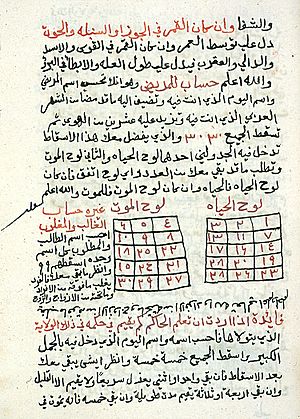Secretum Secretorum facts for kids
The Secretum Secretorum or Secreta Secretorum is a famous book from the Middle Ages. Its Latin name means "Secret of Secrets." It is also known by its Arabic name, Sirr al-Asrar, which means "The Secret Book of Secrets."
This book pretends to be a letter from the famous Greek philosopher Aristotle to his student, Alexander the Great. It covers many different topics. These include how to rule a country, good behavior, understanding people's faces (physiognomy), astrology, alchemy, magic, and medicine.
Even though it says it's by Aristotle, modern experts believe it was actually written in Arabic around the 10th century. It was later translated into Latin in the 12th century. This made it very popular and important among thinkers in Europe during the High Middle Ages.
Contents
Where Did the Book Come From?
No one is completely sure where the Secretum Secretorum first came from. The Arabic version of the book claims it was translated from Greek. It says a scholar named Yahya Ibn al-Batriq translated it in the 9th century. He supposedly worked from a Syriac version, which was itself translated from an original Greek text.
The book contains letters that are supposedly from Aristotle to his student Alexander the Great. However, no such letters have ever been found. It seems the book was actually written in Arabic. The ideas for these letters might have come from popular legends about Alexander the Great in Islamic and Persian cultures.
The Arabic book exists in two main forms. One is longer with 10 sections, and the other is shorter with 7 or 8 sections. The shorter version is found in about 50 copies.
Experts today think the book was written sometime after the Encyclopedia of the Brethren of Purity and before the work of Ibn Juljul in the late 10th century. Parts of the book, like the section on understanding faces, might have been around even earlier.
The Arabic version of the book was translated into many other languages. These include Persian, Ottoman Turkish, Hebrew, and Spanish. It was also translated into Latin twice.
The first Latin translation was only a part of the book. It was made around 1120 for the queen of Portugal by John of Seville. This part was about how to stay healthy. The second Latin translation included the whole book. It was done around 1232 by Philip of Tripoli in Antioch. This full translation is found in over 350 copies. Some versions from the 13th century even have extra sections added to them.
What's Inside the Book?
The Secretum Secretorum says it's a guide written by Aristotle for Alexander. This was supposedly during Alexander's conquest of the Persian Empire. The book covers many different subjects.
It talks about right and wrong for a ruler. It also discusses astrology, which is the study of how stars and planets might affect people. The book also explores the special powers of plants, gems, and numbers for medicine and magic. It even describes a "unified science" that only very wise and good scholars can understand.
An early English translation of the book had sections on:
- How to be a good king.
- Tips for staying healthy.
- Information about the four seasons.
- How the body's natural heat works.
- Advice on food.
- The importance of justice.
- Understanding people by their faces (physiognomy).
- Good manners and behavior.
Later versions of the book, especially from the 13th century, included ideas about alchemy. This was an ancient practice that tried to turn common metals into gold. These versions also contained an early form of the famous Emerald Tablet, a short text important in alchemy.
Why Was This Book Important?
The Secretum Secretorum was one of the most widely read books during the High Middle Ages. Many people even thought it was the most popular book. During a time called the 12th-century Renaissance, when many old Greek texts were rediscovered, medieval readers truly believed Aristotle wrote this book. They treated it as one of his real works.
The book was especially important to a 13th-century English scholar named Roger Bacon. He mentioned it more often than other scholars of his time. Bacon even created his own special copy of the book with his own introduction and notes. This was a very rare honor.
Some scholars in the mid-20th century thought that Bacon's interest in the Secretum Secretorum was key to him developing experimental science. More recent studies are less sure about this. However, they still agree that the book played a big role in Bacon's later research.
Over time, the Latin Secretum Secretorum was translated into many other European languages. These included Czech, Russian, Croatian, Dutch, German, Icelandic, English, Aragonese, Catalan, Spanish, Portuguese, French, Italian, and Welsh. The English translation from 1528 was based on Philip of Tripoli's Latin version.
Interest in the Secretum Secretorum among scholars started to fade around 1550. However, people interested in the occult (mystical or magical things) still read it today. Modern scholars see the book as a way to understand what people thought about during the Middle Ages. It was used in many different scholarly discussions and played a part in the big debates of that time.
See also
 In Spanish: Poridat de poridades para niños
In Spanish: Poridat de poridades para niños


